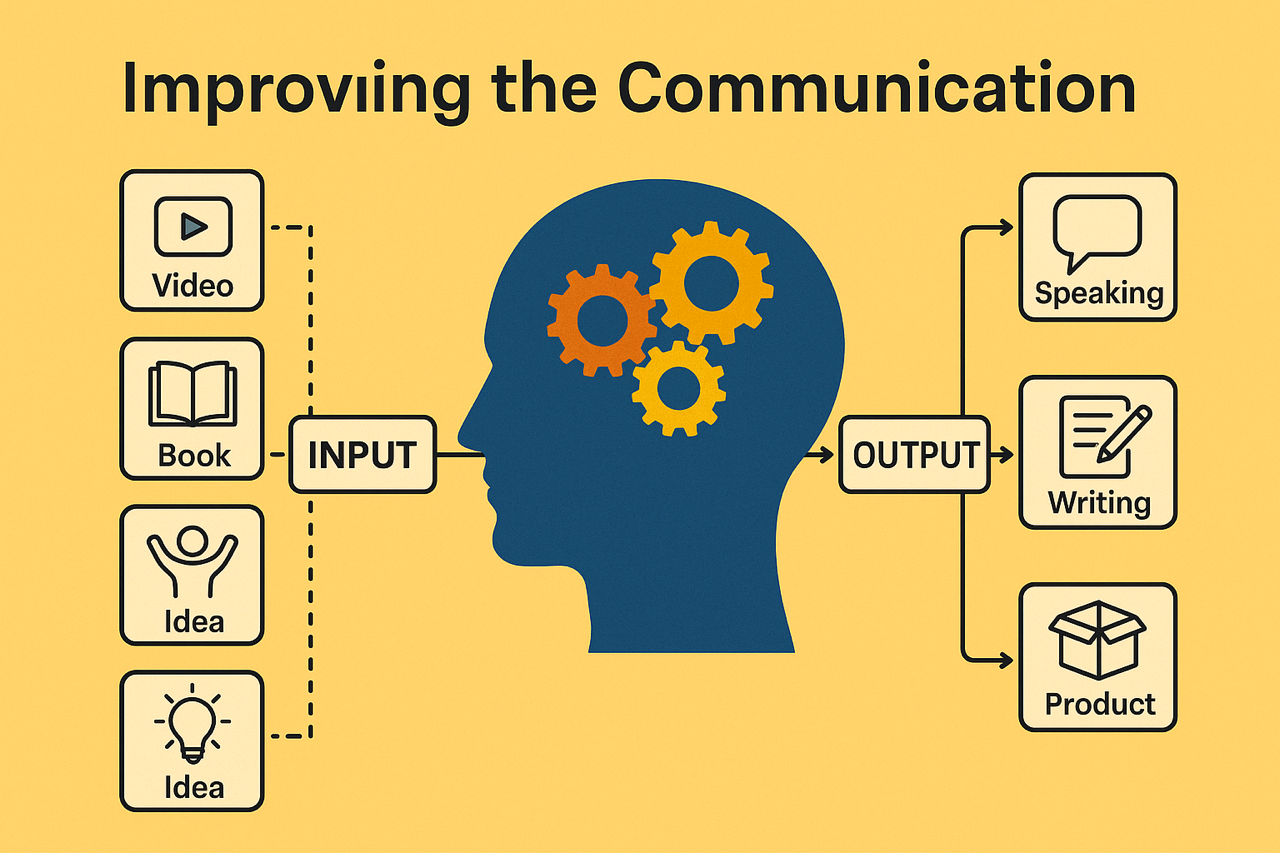
Improving the Communication
The process of communication sometimes brings troubles, and often we over-complicate it, increasing the entropy (we’ll soon see what that means) and generating a poor communication process. To communicate better, we need a clear mind. That reminded me of Shannon’s theory of communication. Here, I synthesize some of his ideas and connect them to our everyday communication.
Input and output
We receive inputs from many sources. It’s important to identify when new information arrives and clarify concepts so we can communicate them later. If the source has poor quality, the digestion process is tricky. Also, if we accumulate too much input without synthesizing, it can backfire.
%%{init: {'theme':'dark'}}%%
flowchart TB
I(INPUT)
a[Video] -.-> I
b[Book] -.-> I
c[Experience] -.-> I
d[Idea] -.-> I
I ==> C
C[Digest and understand
Feynman technique]
C ==> O
O(OUTPUT)
O -.-> e[Speaking]
O -.-> f[Writing]
O -.-> g[Product]
We receive a lot of information, knowing how to synthesize, differentiate, connect, and structure those ideas is a key skill that we need to handle.
Feynman technique in a nutshell
The Feynman Technique is a four-step method of learning that emphasizes understanding by explaining complex topics in simple terms
-
Choose a concept to study: Select the topic or concept you want to understand more deeply.
-
Explain the concept: Write out your explanation of the concept as if you were teaching it to someone else, like a child or someone unfamiliar with the topic.
-
Identify gaps in understanding: As you explain, you will encounter areas where you get stuck or cannot articulate the concept clearly. Go back to your original materials (textbooks, notes) to fill in those gaps and deepen your understanding.
-
Simplify and refine: Review your explanation and cut jargon. Use analogies or examples. If it’s still confusing, return to the material until you can explain it in plain language.
Be descriptive
If you are telling a story—for example, hiking a mountain—describe what you saw, how your breath felt, how the ground was, how the weather was. Were you tired? Were you alone? What were you thinking at that moment?
This pulls people into your story, helps them imagine the scene, and connects your description to their own memories.
Exposition
The best way to improve is practice. I’m not a native English speaker, and this exercise of writing is crucial for me. It’s not perfect, but it exists—and that’s better than nonexistence. Sometimes it’s hard to start, but a good strategy is committing to at least one paragraph. Inspiration comes, and soon you’re immersed. Another idea is to film yourself speaking for one minute. This helps you:
- Clarify your ideas.
- Test if you really understand.
- Improve vocalization, body language and vocabulary.
- Become more comfortable with the topic.
---
title: Communication of Information
---
%%{init: {'theme':'dark'}}%%
flowchart LR
S[SOURCE] --message--> T[TRANSMITER]
T --signal--> CH[CHANNEL]
N[NOISE SOURCE] --noise--> CH
CH --signal--> R[RECEIVER]
R --> D[DESTINATION]
Source: The Mathematical Theory of Communication, Shannon, Claude E.
Shannon mentions these elements that affect the communication:
-
Coding: This is the way that the information is codified for being transmitted, can be a word from our voice, a gesture from our body or symbols like characters.
-
Noise: All the external elements that affect the transmission of the information.
-
Redundancy: How much repeated information is transmitted, for example, how many times you repeat some idea or key point of the topic.
-
Entropy: Measures the uncertainty or surprise in a message. If the message is very predictable (like a routine greeting), entropy is low → little new information. If the message is unpredictable (like a random signal or an unexpected fact), entropy is high → a lot of new information.
Connecting with Noise and Redundancy
Shannon showed that communication is not only about the message, but also about what happens during transmission. A simple way to think about it is:
(Information received): what really arrives at the destination.
(Redundancy): the extra repetition or structure we add to make sure the message survives distortion.
(Noise): the interference that distorts or erases parts of the message.
Entropy is the raw potential information before noise and redundancy are applied. So in practice:
High entropy (lots of surprise in the message) needs redundancy to ensure it gets through.
Low entropy (predictable messages) can travel with little redundancy, but also carries less real information.
In practice
Some question at the time of communication for using these concepts:
%%{init: {'theme':'dark'}}%%
flowchart TB
E{Is there high entropy?}
E -- yes --> R[Increase redundancy]
E -- no --> C[Continue communicating]
N{Is there noise?}
N -- yes --> R
N -- no --> C
R --> C
When is there high entropy?
- When the topic is complex
- When many topics are mixed
- When the program is not well-structured
- When the receptor doesn’t know the topic
Communicate well is a key skill, also help to you to think better, and contribute to others to think better too. The practice made the master, don’t be scared to practice, you can communicate better if you understand what you are doing. I was writing this imperfectly, but that is the key for getting better, nothing perfect can be perfectible.